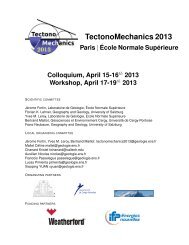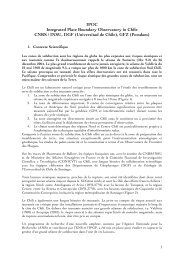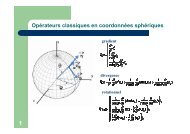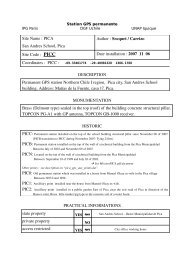PDF file - Laboratoire de Géologie de l'Ecole normale supérieure - Ens
PDF file - Laboratoire de Géologie de l'Ecole normale supérieure - Ens
PDF file - Laboratoire de Géologie de l'Ecole normale supérieure - Ens
Create successful ePaper yourself
Turn your PDF publications into a flip-book with our unique Google optimized e-Paper software.
VIGNY ET AL.: GEODETIC MEASUREMENTS MONITOR ASAL RIFT DEFORMATION<br />
Figure 1. Triple junction and Afar <strong>de</strong>pression (circle by solid line). Dots show locations of GPS stations. Arrows<br />
<strong>de</strong>pict their horizontal velocities with respect to a reference frame fixed on the Somalia Plate. Bold numbers asi<strong>de</strong><br />
the arrows indicate the velocity in mm/yr. Ellipses <strong>de</strong>pict the region of 99% confi<strong>de</strong>nce using the uncertainties in<br />
Table 1.<br />
Far-field velocities<br />
In this Somalia-fixed reference frame, the residual<br />
velocity in Addis Abebba (ADD1), west of the East<br />
African Rift (EAR), is 4 mm/yr (±1 mm/yr at 1sigma),<br />
oriented roughly West (figure 1, table1). The<br />
amplitu<strong>de</strong> of this residual vector <strong>de</strong>pends on the<br />
angular velocity estimated for the Somalia plate.<br />
Different solutions give velocities between 3 and 6<br />
mm/yr (coherent at 2-sigmas) and azimuths between<br />
West and North-West, roughly perpendicular to the<br />
4<br />
EAR trace at this latitu<strong>de</strong>. Therefore, we conclu<strong>de</strong> that<br />
our value of 4 mm/yr ±2 is an upper bound for the EAR<br />
opening rate just south of the Afar <strong>de</strong>pression.<br />
The stations in Yemen (DHAM, HODD, JNAR,<br />
SANA) move together as a coherent block that<br />
represents a part of the Arabia plate with very little<br />
internal <strong>de</strong>formation (figure 1). The azimuth of their<br />
average velocity (N25° ± 5) is compatible with the<br />
orientations of Gulf of A<strong>de</strong>n transform faults used in the<br />
NUVEL-1 mo<strong>de</strong>l [Demets et al., 1990]. On the contrary,<br />
their mean opening speed (13 ± 2 mm/yr) is 30% slower






